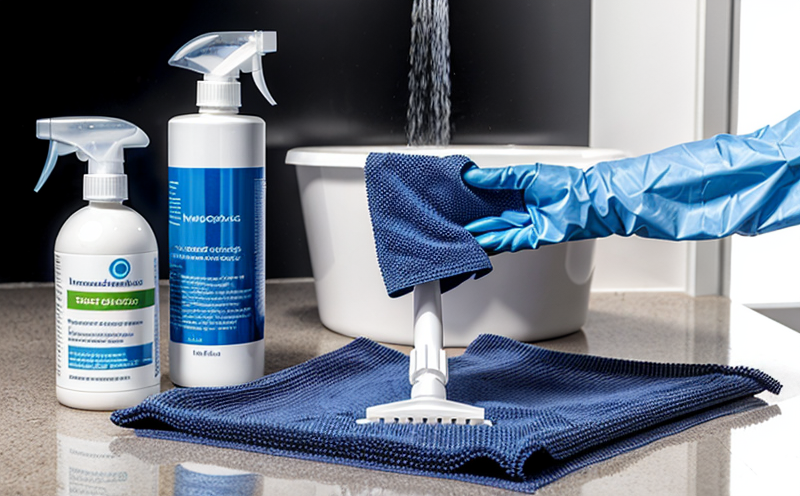ASTM E2149 Antimicrobial Activity of Nanoparticles in Suspension for Hygiene Use
The ASTM E2149 standard provides a method to evaluate the antimicrobial activity of nanoparticles used in suspension within cleaning and hygiene products. This testing ensures that nanomaterials meet stringent performance requirements, guaranteeing safety and efficacy when used in personal care or household products.
In this context, nanomaterials are engineered on the scale of 1-100 nm, offering unique properties such as high surface area to volume ratio and enhanced chemical reactivity. When incorporated into cleaning and hygiene products, these nanoparticles can exhibit superior antimicrobial efficacy compared to larger particle counterparts.
The ASTM E2149 method is particularly relevant for the following:
- Antimicrobial efficacy testing of silver, copper, zinc oxide, titanium dioxide, and other nanomaterials
- Evaluation of nanoparticle suspensions in various cleaning solutions
- Determination of minimum effective concentration (MEC) of nanoparticles required to achieve desired antimicrobial activity
Testing is conducted under controlled conditions that simulate real-world usage. Specimen preparation involves dispersing nanomaterials into a suitable suspension medium, ensuring uniform distribution and stability during the test.
The testing apparatus includes specialized microscopes for particle characterization and incubators to maintain appropriate environmental conditions. The process follows these key steps:
- Preparation of nanoparticle suspensions at different concentrations
- Inoculation with standardized bacterial or fungal strains (e.g., Escherichia coli, Staphylococcus aureus)
- Incubation under specified temperature and humidity conditions
- Maintenance of specimen for a defined period to observe microbial growth
- Determination of minimum effective concentration using colony-forming unit (CFU) counts
The ASTM E2149 standard specifies acceptance criteria based on CFU reduction compared to control samples. Successful results indicate that the nanomaterial suspension meets industry standards for antimicrobial efficacy.
Quality managers and compliance officers benefit from this testing by ensuring product safety and regulatory compliance. R&D engineers can optimize nanoparticle formulations, while procurement professionals ensure consistent supply of high-quality materials.
The ASTM E2149 method is widely recognized in the cleaning and hygiene sector for its rigorous approach to validating nanomaterials. Compliance with this standard enhances brand reputation and consumer trust, contributing significantly to market competitiveness.
Industry Applications
The ASTM E2149 testing is vital across various sectors where nanomaterials play a crucial role in enhancing hygiene and sanitation. Key applications include:
- Paper towels infused with silver nanoparticles for enhanced antimicrobial properties
- Disinfectant wipes containing copper-based suspensions for effective sanitization
- Toilet paper treated with titanium dioxide to inhibit bacterial growth on contact surfaces
- Detergents and soaps formulated with zinc oxide nanoparticles to reduce pathogenic bacteria
The versatility of nanomaterials allows their integration into a wide range of products, from household cleaning agents to medical devices. The ASTM E2149 method ensures that these materials perform reliably under real-world conditions.
By adhering to this standard, manufacturers can demonstrate compliance with international regulations and consumer expectations for hygiene products. This not only enhances product safety but also supports sustainable practices in the industry.
Environmental and Sustainability Contributions
The ASTM E2149 testing plays a significant role in promoting environmental sustainability by ensuring that nanomaterials used in cleaning and hygiene products are safe for both humans and the environment. The method helps identify potential risks associated with nanoparticle exposure, allowing manufacturers to take necessary precautions.
One key aspect is the assessment of nanoparticle stability during product use. Unstable nanoparticles may degrade over time, potentially leading to environmental contamination. By adhering to ASTM E2149 standards, manufacturers can minimize such risks and contribute positively to environmental conservation efforts.
The testing also evaluates the biodegradability and ecotoxicity of nanomaterials used in hygiene products. This ensures that any potential environmental impact is minimized, aligning with broader sustainability goals within the industry.
Through rigorous testing and adherence to standards like ASTM E2149, manufacturers can ensure that their products not only meet regulatory requirements but also contribute positively to sustainable practices. This approach fosters trust among consumers who are increasingly concerned about environmental impact.
Use Cases and Application Examples
The ASTM E2149 method is applied in diverse scenarios where nanomaterials are used for enhanced hygiene properties. Some notable use cases include:
- Paper Towels: Infusing paper towels with silver nanoparticles to create an antimicrobial surface.
- Detergents: Incorporating zinc oxide nanoparticles into laundry detergents to reduce bacterial growth in textiles.
- Toilet Paper: Treating toilet paper with titanium dioxide to inhibit bacterial colonization on contact surfaces.
- Disinfectant Wipes: Formulating disinfectant wipes with copper-based suspensions for effective sanitization.
In each of these scenarios, the ASTM E2149 method ensures that nanomaterials perform optimally under real-world conditions. This enhances product efficacy while ensuring safety and regulatory compliance.
By leveraging this standard, manufacturers can develop innovative products that meet both consumer expectations for hygiene and environmental sustainability. The ASTM E2149 testing process provides a robust framework for evaluating the performance of nanomaterials in cleaning and hygiene applications.





